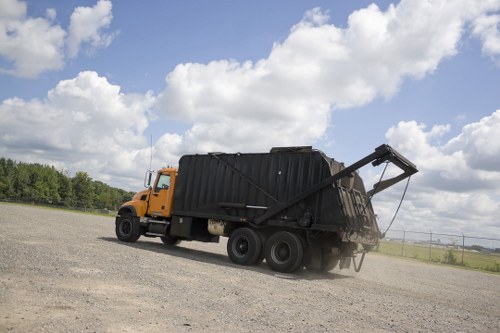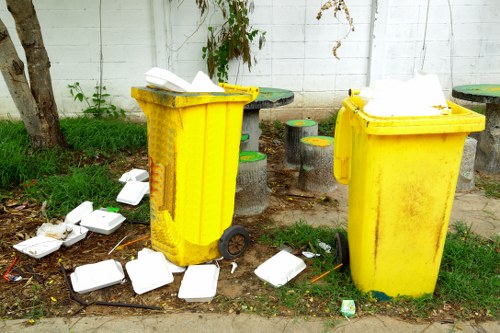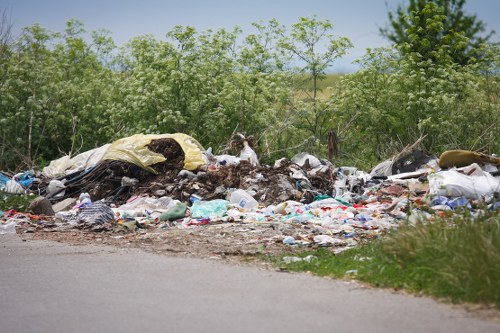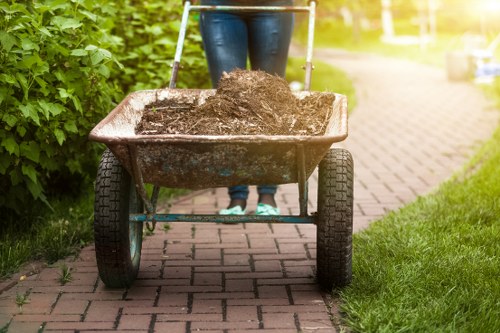Comprehensive Guide to Construction Waste Clearance in Lambeth
Understanding Construction Waste Clearance

Construction projects in Lambeth generate a significant amount of waste that needs to be managed effectively. Proper construction waste clearance ensures that your site remains safe, compliant with local regulations, and environmentally friendly.
Managing waste efficiently can also lead to cost savings and contribute to a positive reputation for your business. Whether you're undertaking a small renovation or a large-scale construction project, understanding the essentials of waste clearance is crucial.
In this section, we'll explore the basics of construction waste clearance, its importance, and the benefits it brings to both your project and the community.
Types of Construction Waste

Construction waste can be categorized into various types, each requiring specific handling and disposal methods. Common types include:
- Concrete and Masonry: Includes broken bricks, concrete, and tiles.
- Wood and Timber: Scrap lumber, plywood, and other wooden materials.
- Metals: Steel, aluminum, and other recyclable metals.
- Plastics: PVC pipes, insulation materials, and other plastic components.
- Hazardous Waste: Asbestos, lead-based paints, and other dangerous substances.
Proper segregation of these materials is essential for effective waste management and recycling.
Failure to categorize waste correctly can lead to increased disposal costs and potential legal issues.
Regulations and Compliance in Lambeth

Lambeth has specific regulations governing construction waste clearance to ensure environmental protection and public safety. Compliance with these guidelines is mandatory for all construction activities.
Key regulations include:
- Waste Disposal Permits: Obtaining the necessary permits before disposing of large quantities of waste.
- Recycling Requirements: Mandatory recycling of certain materials like metals and plastics.
- Hazardous Waste Handling: Specialized procedures for disposing of dangerous substances.
- Reporting: Regular reporting of waste management practices to local authorities.
Adhering to these regulations not only avoids fines but also promotes sustainable construction practices.
Engaging with a professional waste clearance service can help navigate these complex requirements.
Benefits of Professional Waste Clearance Services

Hiring a professional construction waste clearance service in Lambeth offers numerous advantages:
- Efficiency: Experts can manage waste quickly and effectively, minimizing project delays.
- Compliance: Ensures all legal and environmental regulations are met.
- Cost-Effective: Reduces overall project costs by optimizing waste management processes.
- Environmental Responsibility: Promotes recycling and reduces landfill usage.
- Safety: Proper handling of waste prevents accidents and health hazards on-site.
Choosing the right service provider can make a significant difference in the success and sustainability of your construction project.
It's important to select a company with a proven track record and comprehensive services.
Steps Involved in Construction Waste Clearance

The process of construction waste clearance involves several key steps to ensure efficiency and compliance:
- Assessment: Evaluating the type and volume of waste generated.
- Segregation: Sorting waste into categories for appropriate handling.
- Collection: Gathering waste from the construction site.
- Transportation: Moving waste to designated disposal or recycling facilities.
- Disposal/ Recycling: Properly disposing of or recycling materials based on their categories.
Each step must be meticulously planned and executed to maintain efficiency and regulatory compliance.
Working with experienced professionals ensures that each phase is handled correctly.
Environmental Impact of Construction Waste
Construction waste has a considerable impact on the environment if not managed properly. Improper disposal can lead to soil contamination, water pollution, and increased greenhouse gas emissions.
Recycling materials like metals and plastics reduces the need for virgin resources, thereby conserving natural habitats and reducing carbon footprints.
Implementing sustainable waste management practices contributes to the overall health of the ecosystem and supports global environmental goals.
Choosing the Right Waste Clearance Partner in Lambeth
Selecting a reliable waste clearance service is crucial for the success of your construction project. Consider the following factors when making your choice:
- Experience: Look for companies with extensive experience in construction waste management.
- Licensing and Certifications: Ensure they are licensed and adhere to industry standards.
- Comprehensive Services: Choose providers that offer a full range of services from assessment to disposal.
- Customer Reviews: Check feedback from previous clients to gauge reliability and quality of service.
- Pricing: Compare quotes to find a service that fits your budget without compromising on quality.
Partnering with the right company ensures that your waste clearance needs are met efficiently and responsibly.
Don’t hesitate to ask for references or case studies to better understand their capabilities.
Cost Factors in Construction Waste Clearance
The cost of construction waste clearance in Lambeth can vary based on several factors:
- Volume of Waste: Larger projects generate more waste, increasing disposal costs.
- Type of Waste: Hazardous materials require special handling, which can be more expensive.
- Location: Accessibility of the site may impact transportation costs.
- Service Frequency: Regular clearance services might offer discounts compared to one-time collections.
- Additional Services: Extra services like on-site sorting or recycling can affect the overall cost.
Understanding these factors helps in budgeting and selecting a cost-effective waste clearance solution.
It's advisable to obtain multiple quotes and compare the services offered to make an informed decision.
Innovative Solutions in Waste Management
The construction industry is evolving with innovative waste management solutions that enhance efficiency and sustainability. Some of these advancements include:
- Recycling Technologies: Advanced technologies for better sorting and recycling of materials.
- Waste Tracking Systems: Digital platforms to monitor waste generation and disposal in real-time.
- Circular Economy Practices: Designing projects to minimize waste and promote the reuse of materials.
- Green Building Certifications: Adhering to standards that emphasize responsible waste management.
- Eco-Friendly Disposal Methods: Utilizing environmentally safe methods for waste disposal.
Adopting these innovative approaches can lead to more sustainable construction practices and reduce the environmental footprint of your projects.
Staying updated with the latest trends in waste management can provide a competitive edge in the construction industry.
Case Studies: Successful Waste Clearance in Lambeth
Examining real-life examples of effective construction waste clearance in Lambeth highlights best practices and achievable outcomes:
- Residential Project: Successfully managed 5 tons of construction waste through effective segregation and recycling.
- Commercial Development: Implemented a waste tracking system that reduced disposal costs by 20%.
- Renovation Project: Handled hazardous materials safely, ensuring compliance with all regulations.
- Infrastructure Upgrade: Utilized circular economy practices to maximize material reuse.
These case studies demonstrate the tangible benefits of professional waste clearance services.
They also provide insights into strategies that can be replicated in future projects.
Future Trends in Construction Waste Clearance
The future of construction waste clearance in Lambeth is poised for significant advancements driven by technology and sustainability goals. Anticipated trends include:
- Increased Automation: Use of AI and robotics for sorting and processing waste more efficiently.
- Enhanced Recycling Techniques: Development of new methods to recycle complex materials.
- Sustainable Material Use: Greater emphasis on using recyclable and eco-friendly materials from the outset.
- Regulatory Changes: Stricter regulations promoting higher standards of waste management.
- Community Engagement: Encouraging community involvement in recycling and waste reduction initiatives.
Staying abreast of these trends will be essential for businesses looking to maintain sustainable practices and comply with future regulations.
Embracing innovation can lead to more effective and environmentally responsible waste management solutions.
Tips for Effective Construction Waste Management
Implementing strategic practices can enhance your construction waste management process:
- Plan Ahead: Incorporate waste management into the project planning phase.
- Educate Your Team: Train workers on proper waste segregation and disposal methods.
- Monitor Waste Generation: Keep track of the amount and type of waste produced.
- Partner with Experts: Collaborate with professional waste clearance services for optimal results.
- Promote Recycling: Encourage the reuse and recycling of materials wherever possible.
These tips not only streamline the waste management process but also contribute to a more sustainable construction environment.
Consistency and attention to detail are key to successful waste clearance.
Impact on Local Community and Environment
Proper construction waste clearance has a positive impact on the local community and environment in Lambeth:
Reducing waste disposal sites minimizes the strain on local landfills, preserving natural landscapes and reducing pollution.
Recycling materials decreases the demand for new resources, conserving energy and reducing carbon emissions.
Creating a cleaner environment enhances the quality of life for residents and supports sustainable urban development.
Common Challenges in Construction Waste Clearance
Despite its importance, construction waste clearance faces several challenges:
- Volume Management: Handling large volumes of waste can be logistically challenging.
- Regulatory Complexity: Navigating the intricate regulations requires expertise.
- Cost Constraints: Budget limitations may affect the scope of waste management practices.
- Material Segregation: Ensuring proper segregation of different waste types is often difficult.
- Awareness: Lack of awareness about the benefits of recycling and proper waste management can hinder efforts.
Addressing these challenges involves strategic planning, education, and collaboration with professional services.
Overcoming obstacles can lead to more effective and sustainable waste clearance practices.
Technological Advancements in Waste Clearance
Technology plays a pivotal role in enhancing construction waste clearance processes:
- Digital Tracking Systems: Enable real-time monitoring of waste generation and disposal.
- Advanced Sorting Equipment: Improves the efficiency of material segregation and recycling.
- Automated Transport Solutions: Streamlines the movement of waste from site to disposal facilities.
- Data Analytics: Provides insights into waste patterns, helping to optimize management strategies.
- Mobile Apps: Facilitate communication and coordination among waste management teams.
Integrating these technologies can lead to more efficient, cost-effective, and environmentally friendly waste clearance operations.
Embracing innovation ensures that your waste management practices remain cutting-edge and compliant.
Sustainable Practices for Long-Term Success
Adopting sustainable practices in construction waste clearance ensures long-term environmental and economic benefits:
- Minimize Waste Generation: Design projects with minimal waste in mind.
- Maximize Recycling: Prioritize the recycling of all recyclable materials.
- Use Eco-Friendly Materials: Choose materials that are sustainable and easier to recycle.
- Continuous Improvement: Regularly assess and improve waste management strategies.
- Community Involvement: Engage with the local community to promote sustainable practices.
Commitment to sustainability not only benefits the environment but also enhances your reputation and compliance with future regulations.
Implementing these practices lays the foundation for responsible and efficient waste management.
Conclusion: Prioritizing Waste Clearance in Lambeth
Effective construction waste clearance in Lambeth is essential for the success of any construction project. It ensures compliance with regulations, promotes environmental sustainability, and contributes to cost savings.
By understanding the types of waste, adhering to local regulations, and partnering with professional waste clearance services, you can manage waste efficiently and responsibly.
Embracing sustainable practices and staying informed about technological advancements will further enhance your waste management strategies, leading to long-term benefits for your projects and the community.
Contact us today to learn how we can assist you with your construction waste clearance needs in Lambeth.